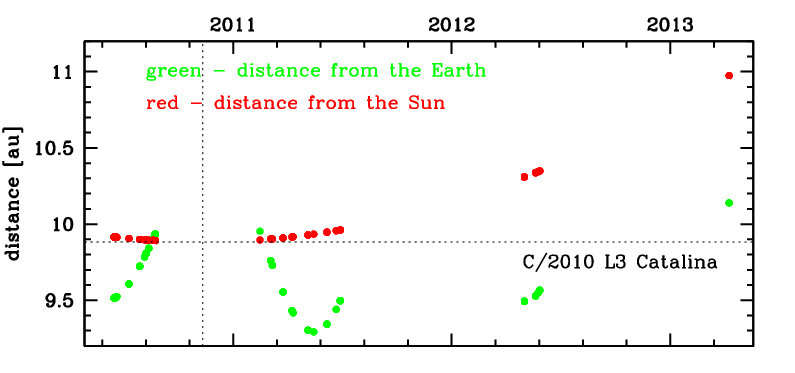C/2010 L3 Catalina
more info
Comet C/2010 L3 was discovered on 15 June 2010 in a course of Catalina Sky Survey, and next rarely observed 2.8 yr during four oppositions in a range of heliocentric distances: 9.92 au – 9.883 au (perihelion) – 11.0 au. At the moment of discovery, it was five months before perihelion passage (see figure).
Comet had its closest approach to the Earth on 14 May 2011 (9.293 au, six months after perihelion).
This comet suffers small planetary perturbations during its passage through the planetary system that lead to a less tight future orbit with semimjor axis larger than 10000 au (see future barycentric orbit).
See also Królikowska and Dybczyński 2017.
Comet had its closest approach to the Earth on 14 May 2011 (9.293 au, six months after perihelion).
This comet suffers small planetary perturbations during its passage through the planetary system that lead to a less tight future orbit with semimjor axis larger than 10000 au (see future barycentric orbit).
See also Królikowska and Dybczyński 2017.
| solution description | ||
|---|---|---|
| number of observations | 123 | |
| data interval | 2010 06 15 – 2013 04 08 | |
| data type | perihelion within the observation arc (FULL) | |
| data arc selection | entire data set (STD) | |
| range of heliocentric distances | 9.92 au – 9.88 au (perihelion) – 11 au | |
| detectability of NG effects in the comet's motion | NG effects not determinable | |
| type of model of motion | GR - gravitational orbit | |
| data weighting | YES | |
| number of residuals | 245 | |
| RMS [arcseconds] | 0.39 | |
| orbit quality class | 1a | |
| orbital elements (heliocentric ecliptic J2000) | ||
|---|---|---|
| Epoch | 2010 11 20 | |
| perihelion date | 2010 11 10.47076512 | ± 0.00827091 |
| perihelion distance [au] | 9.88282514 | ± 0.00003420 |
| eccentricity | 0.99909456 | ± 0.00002132 |
| argument of perihelion [°] | 121.774413 | ± 0.000361 |
| ascending node [°] | 38.276041 | ± 0.000041 |
| inclination [°] | 102.630673 | ± 0.000036 |
| reciprocal semi-major axis [10-6 au-1] | 91.62 | ± 2.16 |
